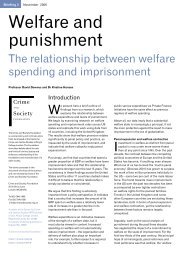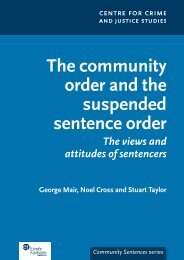PRISON SERVICE
PRISON SERVICE
PRISON SERVICE
- No tags were found...
You also want an ePaper? Increase the reach of your titles
YUMPU automatically turns print PDFs into web optimized ePapers that Google loves.
CHART 6Average percentage attendance of prisoners at each of theformal Therapy Interventions100959085807570IndT CIGT SFTG ARTG OFTG ABTG HSRTGChange in BehaviourAlmost the men on the unit had problematicbehaviours in prison prior to coming into treatment.The interpersonal difficulties that these men had inthe outside world become more intensified within aprison environment. This can lead the men to at bestbecome belligerent and refuse orders and at worst beverbally and physically aggressive. Several of the menhad also previously taken hostages. The first cohort ofmen was a particularly difficult group, as they weresent as the unit opened. Almost all had been inrepeated or constant segregation for several yearsbefore coming onto the unit.Whilst being on the unit the interpersonalbehaviours of these men improved over time asrelationships developed and thus dynamic securityincreased. Also the approach to these men was verydifferent in that explicit communication was usedwith them by all staff with whom they had contact. 2The number of incidents per year that this group ofprisoners was responsible for perpetrating reduceddramatically. It has been argued that this dramaticreduction in number of adjudications can in part beaccounted for by a greater level of tolerance to verbalabuse. This is accepted; however, in many ways thegreater number of staff can lead to more incidents asofficers are constantly observing prisoners and willpick up on and challenge minor incidents that maynot be seen on other wings. On the unit, all refusalsto follow a direct order, serious verbal aggression andall physical acts of aggression, against others oragainst property are subject to adjudication.The figures available prior to coming onto theunit are almost certainly an underestimation due tounavailability of all records, whereas whilst on theunit every incident has been recorded. Nevertheless,even counting those incidents that were previouslyrecorded, it can be seen that that is a highlysignificant reduction in such incidents per year aftertransferring to the unit. Prior to coming on the unitthese prisoners were jointly responsible for anaverage of 18.4 aggressive incidents per year(considerable underestimation due to missing data).After coming onto the unit the same prisoners werejointly responsible for an average of 2.4 aggressiveincidents per year. This was calculated by summingthe average number of incidents per year across all 18prisoners both prior to and after coming onto theunit. This, of course, represents a significantreduction in both the costs of suffering, to officers,other prisoners and the prisoners themselves and alsoa large financial saving in terms of cost of staff timeof sick replacing property and compensation.2. Murphy N., & McVey, D (2010) Fundamental Treatment Strategies for Optimising Interventions With People with Personality Disorder inTreating Severe Personality Edited by Naomi Murphy & Des McVey. Routledge: London.Issue 192 Prison Service Journal51











